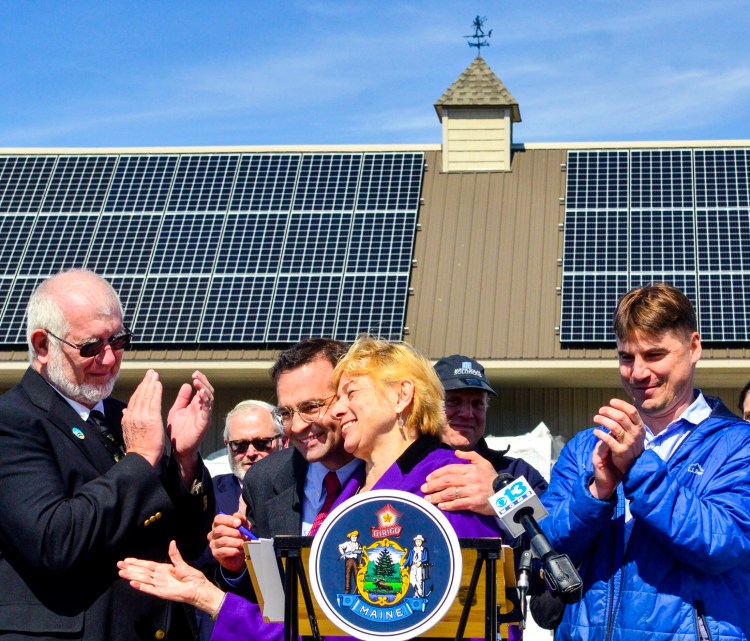Clean-energy supporters are celebrating the pending passage of two bills that they see as catalysts to advance a new wave of renewable power development in Maine.
The first, L.D. 1494, will update Maine’s Renewable Portfolio Standard, a policy that requires increased production of electricity from indigenous sources such as wind, solar, biomass and hydro. The RPS bill aims to double the percentage of renewable power sold in the state to 80 percent by 2030, and 100 percent by 2050. The Senate approved the measure unanimously, the House by a 93-48 margin.
The second, L.D. 1711, would expand a range of solar electric projects, most notably by increasing an arbitrary cap on the number of customers who can receive power from a community solar farm from nine to 200. It was approved with a 32-2 vote in the Senate and 93-52 in the House.
Both bills were on their way Wednesday to Gov. Janet Mills. The governor, a Democrat, has voiced support for clean-energy polices and for blunting the impacts of climate change. She is expected to sign them in the coming days.
“Mainers have been waiting for this kind of climate action for a long time,” said Kathleen Meil with Maine Conservation Voters. “Recent polling tells us that the vast majority of Maine people support transitioning to 100 percent clean energy by 2050, if not before, and these policies put us on the pathway to meet this goal.”
A solar installer in Searsport said L.D. 1711 will provide a new option for residents and business owners who can’t put panels on their properties.
“Many Maine seniors, renters and low- to moderate-income people have been missing out on the benefits of solar energy,” says Chuck Piper, co-owner of Sundog Solar. “Community solar farms create equal access for people that could not otherwise use solar electricity.”
Community solar offers a subscription model for purchasing solar electricity, Piper said, eliminating the upfront investment and lowering individual costs by sharing them among many consumers.
Despite earlier opposition, the RPS bill won support from industrial power customers, following an amendment that allows them to opt out of the requirement. Paper mills and other large, energy-intensive manufacturers had warned at a hearing last month that increasing the renewable portfolio standard could lead to higher costs for them and threaten their ability to compete.
Passage of the solar bill served as a marker for how abruptly Maine’s energy policy has shifted following last year’s election. Similar solar bills that won initial approval in the Legislature were vetoed three years in a row by former Republican Gov. Paul LePage. Under pressure from Republican leadership, these proposals never received enough support in subsequent votes for an override.
By contrast, L.D. 1711 was sponsored by the Senate’s Republican leader, Dana Dow, R-Waldoboro.
But detractors still were taking shots on Wednesday. Jim LaBrecque, a longtime solar-policy antagonist who served as LePage’s technical adviser on energy, used his radio show on WVOM to bash the law and predict it would raise electric bills.
“They’re out of control down there in Augusta,” he told his audience.
But supporters predicted the bills would spur economic development, as well as clean energy benefits.
The Natural Resources Council of Maine cited estimates that the solar bill would create more than 500 new jobs.
The Maine Renewable Energy Association testified last month that the RPS law could create 1,900 jobs over the next 10 years. It also is expected to attract roughly $640 million in investment, mostly through solar projects. The trade group estimated that power from these projects would increase a typical home’s electric bill by only 1 percent or so.
“After eight years of effectively doing nothing, we’re taking major steps for climate change, and for economic development,” said Jeremy Payne, the group’s executive director.
Payne also pointed to a key provision in the RPS bill that charges the Public Utilities Commission with seeking bids for new power projects. The agency would approve the best deals based on rates, but also on economic benefits including job creation and tax revenue.
Progress on the RPS goals will be measured by a future report to the Legislature’s energy committee.
RPS policies are in place in 29 states and Washington, D.C. They recently were the subject of an economic study discussed in a Forbes magazine article, which explored the paradox of rates rising at a time when the cost of renewable generation is falling.
The working paper generally found that retail rates went up, while the carbon emissions associated with climate change dropped only modestly. Among other things, it blamed the added cost of transmission lines and need for quick-start power plants to back up the intermittent output of solar and wind.
Payne said those factors vary, based on a region’s fuel mix and the distance from energy projects to population centers. In Maine, he expects many of the anticipated community and commercial-scale solar projects to be near grid connections, reducing the need for costly transmission upgrades.
Send questions/comments to the editors.




Comments are no longer available on this story